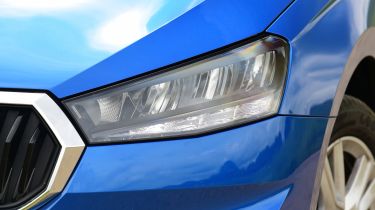Skoda Fabia hatchback - Engines, drive & performance
The small Skoda offers a reassuring big-car feel
While the outgoing Fabia soldiered on with parts from much older cars, the latest model now gets newer technology and a significant size increase. It's especially noticeable how much wider it is and this improves stability, which has always been a Fabia trademark. Now it feels even more solid and secure, and does a good job of convincing you it's a larger car from the driver's seat.
We wouldn't go so far as to call it sporty because the Fabia still feels more focused on comfort than the Hyundai i20. Instead, its steering feels more natural and it has a level of polish that moves it much closer to the Volkswagen Polo and Renault Clio.
Skoda Fabia petrol engines
Skoda only offers the Fabia with front-wheel-drive and petrol power, however, there are three different engines to choose from. The range-topping 1.5-litre powertrain is only available on Monte Carlo and produces a potent 148bhp. While this is no match for the likes of the Volkswagen Polo GTI, the Fabia Monte Carlo feels relatively brisk. Unlike the rest of the Fabia range, this model is only available with a seven-speed DSG gearbox; getting from 0-62mph takes around eight seconds.
The mid-range turbocharged 1.0-litre TSI is familiar to anyone who has driven any small Volkswagen Group cars over the last few years. This is available in 94bhp and 108bhp outputs, with the latter taking 10 seconds to get from 0-62mph. Both engines can be specified with either a six-speed manual or the aforementioned DSG automatic; the DSG can be slow to respond at times, and acceleration is often accompanied by an obtrusive grunt from the engine.
More reviews
In-depth reviews
- Skoda Fabia review – a great-value, practical supermini
- Skoda Fabia vRS review (2010-2014)
- Skoda Fabia hatchback - Interior & comfort
- Skoda Fabia hatchback - Practicality & boot space
- Skoda Fabia hatchback - Reliability & safety
- Skoda Fabia hatchback - MPG, running costs & CO2
- Skoda Fabia hatchback review (2015-2021)
During normal driving, the engine is far quieter at low revs, with a smooth and subdued character. It’s impressive at motorway speeds, where the engine noise is barely noticeable over road noise, which can be quite loud at times. For most drivers, we expect the slick manual gearbox will provide a more satisfying driving experience over the DSG automatic.
It’s also very comfortable for a supermini, with a softer ride that makes it relaxing to drive. The handling is fairly neutral too, with a numb steering feel meaning the Fabia lacks the fun factor or driver involvement possessed by rivals such as Ford Fiesta or Renault Clio. However, regardless of the lack of fun, the Fabia offers precise and secure handling for a supermini.
Unless you're a young driver who needs the lowest possible insurance group, or you only occasionally leave the town and suburbs, we'd avoid the 1.0-litre MPI engine. While its 79bhp might not sound too far off the 94bhp of the cheapest TSI engine, the lack of a turbocharger means it has around half the pulling power. This gives it a 0-62mph time of 15.6 seconds (versus 10.7 for the 94bhp TSI engine) and it feels like harder work to drive as a result, with overtakes requiring serious planning. While its short gearing and slick manual gearbox mean even the MPI can feel perfectly adequate in urban settings, we found it is especially sensitive to hills, which almost always require shifting into a lower gear to maintain momentum.
Which Is Best?
Cheapest
- Name1.0 MPI 80 SE Edition 5dr
- Gearbox typeManual
- RRP£20,835
Most Economical
- Name1.0 TSI Design Edition 5dr
- Gearbox typeManual
- RRP£22,210
Fastest
- Name1.5 TSI 177 130 5dr DSG
- Gearbox typeSemi-auto
- RRP£29,775










